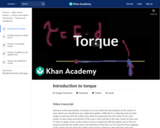
An introduction to torque. Created by Sal Khan.
- Subject:
- Physical Science
- Physics
- Material Type:
- Lesson
- Provider:
- Khan Academy
- Provider Set:
- Khan Academy
- Author:
- Sal Khan
- Date Added:
- 07/02/2021

An introduction to torque. Created by Sal Khan.
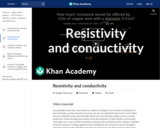
Let's look at the properties of materials that cause a resistor to resist the flow of current. Created by David SantoPietro.

In this video David derives the formula to find the power used by a resistor. Created by David SantoPietro.
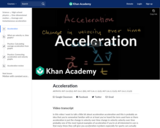
Acceleration (a) is the change in velocity (Δv) over the change in time (Δt), represented by the equation a = Δv/Δt. This allows you to measure how fast velocity changes in meters per second squared (m/s^2). Acceleration is also a vector quantity, so it includes both magnitude and direction. Created by Sal Khan.
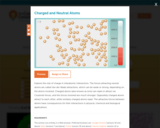
Explore the role of charge in interatomic interactions. The forces attracting neutral atoms are called Van der Waals attractions, which can be weak or strong, depending on the atoms involved. Charged atoms (also known as ions) can repel or attract via Coulomb forces, and the forces involved are much stronger. Oppositely charged atoms attract to each other, while similarly charged atoms repel. The attractive forces between atoms have consequences for their interactions in physical, chemical and biological applications.
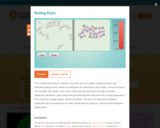
This model allows you to explore why polar and non-polar substances have very different boiling points. While all molecules are attracted to each other, some attractions are stronger than others. Non-polar molecules are attracted through a London dispersion attraction; polar molecules are attracted through both the London dispersion force and the stronger dipole-dipole attraction. The force of attractions between molecules has consequences for their interactions in physical, chemical and biological applications.

Students study magnetic field by using a classroom-made magnetometer. They use iron filings to reveal the magnetic field lines and record their observations on a sketch map.

In this activity, students conduct experiments using an egg and a graduated cylinder filled with liquids of different densities. By observing how different densities affect the egg's position in the cylinder, they can draw important connections to the Earth's lithosphere, hydrosphere, and atmosphere.
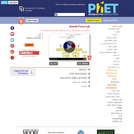
Visualize the gravitational force that two objects exert on each other. Change properties of the objects in order to see how it changes the gravity force.

This hands-on OLogy experiment uses Jell-O, fruit, nuts, and candy to demonstrate how space bends around anything that has mass. The activity begins with kid-friendly introductions to the concept of mass and Einstein's theory of bending space. The illustrated, step-by-step directions include notes about how the fruit, nuts, and candy represent stars, planets, and other objects in space. At the end, kids are encouraged to celebrate their new-found knowledge by digging into their edible space.
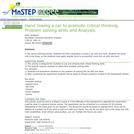
This towing lab students use a active learning activity to develop planning, problem solving and conceptual skills to clarify understanding of applied and net force. The assessment is the correct composition of a vector diagram.

This is an activity about using solar arrays to provide power to the space station. Learners will solve a scenario-based problem by calculating surface areas and determining the amount of power or electricity the solar arrays can create. This is mathematics activity 1 of 2 found in the ISS L.A.B.S. Educator Resource Guide.
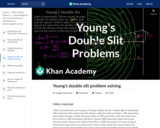
An example problem involving a double slit experiment. Created by David SantoPietro.

This is an activity about keeping astronauts safe from debris in space. Learners will investigate the relationship between mass, speed, velocity, and kinetic energy in order to select the best material to be used on a space suit. They will apply an engineering design test procedure to determine impact strength of various materials. This is engineering activity 2 of 2 found in the ISS L.A.B.S. Educator Resource Guide.
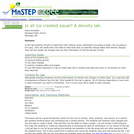
This lab helps students to understand the density is state dependent and can change based on the state of the element.

In this activity, students build a simple computer model to determine the black body surface temperature of planets in our solar system: Mercury, Venus, Earth, Mars, Jupiter, Saturn, Uranus, Neptune and Pluto. Experiments altering the luminosity and distance to the light source will allow students to determine the energy reaching the object and its black body temperature. The activity builds on student outcomes from activity A, "Finding a Mathematical Description of a Physical Relationship." It also supports inquiry into a real-world problem, the effect of urban heat islands and deforestation on climate. Includes a teacher's guide, student worksheets, and an Excel tutorial. This is Activity B of module 3, titled "Using Mathematic Models to Investigate Planetary Habitability," of the resource, Earth Climate Course: What Determines a Planet's Climate? The course aims to help students to develop an understanding of our environment as a system of human and natural processes that result in changes that occur over various space and time scales.

In this activity, students learn to interpret current weather maps. They will observe weather map loop animations on the internet, learn the concept of Zulu time (Universal Time Coordinated, UTC) and visualize the movement of fronts and air masses. They will then analyze a specific weather station model, generate a meteogram from their observations, and answer a set of questions about their observations.

Class website: The Once & Future City
What is a city? What shapes it? How does its history influence future development? How do physical form and institutions vary from city to city and how are these differences significant? How are cities changing and what is their future? This course will explore these and other questions, with emphasis upon twentieth-century American cities. A major focus will be on the physical form of cities—from downtown and inner-city to suburb and edge city—and the processes that shape them.
These questions and more are explored through lectures, readings, workshops, field trips, and analysis of particular places, with the city itself as a primary text. In light of the 2016 centennial of MIT’s move from Boston to Cambridge, the 2015 iteration of the course focused on MIT’s original campus in Boston’s Back Bay, and the university’s current neighborhood in Cambridge. Short field assignments, culminating in a final project, will provide students opportunities to use, develop, and refine new skills in “reading” the city.

In this activity, students use mathematics to understand tides and gravitation and how gravity works across astronomical distances, using an apparatus made from a slinky, meter stick, and a hook. A description of the mathematical relationships seen in the demonstration is included. The resource is from PUMAS - Practical Uses of Math and Science - a collection of brief examples created by scientists and engineers showing how math and science topics taught in K-12 classes have real world applications.
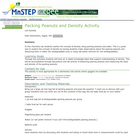
Exploring Density Lab using packing peanuts, tons of fun!